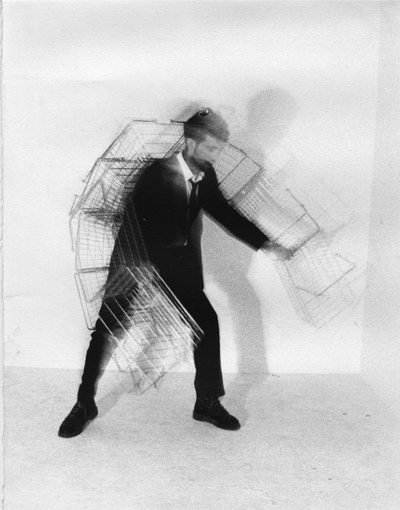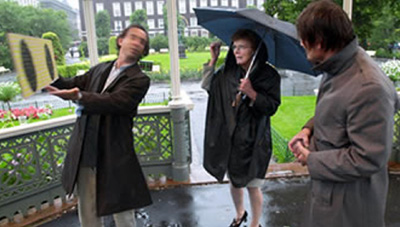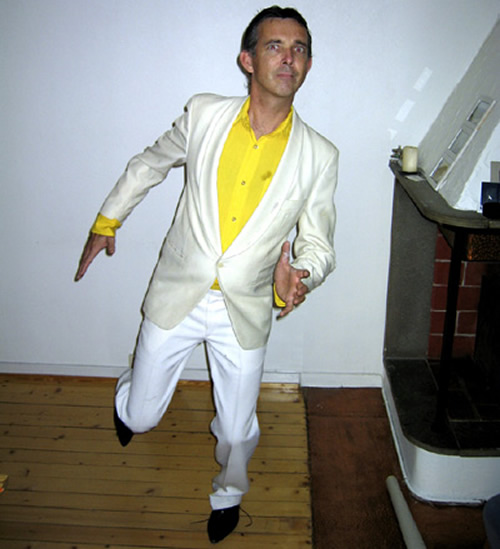"I said that if Jørgen (Lund) was going to write Terje into the history of art, then it would be my job to write him out!"
Geir Tore Holm (2001) for the catalogue
TERJE NICOLAISEN (2001), Norsk Sokkel Forlag TN
Debut monograph with texts from
Gardar Eide Einarsson, Geir Tore Holm, Jørgen Lund and Per Teljer.
Published by Terjes own label Norsk Sokkel Forlag ISBN: 82-994301-2-7
Translation: Tom Ellett
Factual Details/ -Paintings
Geir Tore Holm
If I remember rightly, I first met Terje Nicolaisen in May 1993. He was sitting his entrance examination for the Academy of Fine Arts in Trondheim and presented a small vitrine containing an impression of Robert Zeitzeug’s mouth for giving oral readings of time and place. He arrived for the examination at the Academy bringing nothing but a bricklayer’s spirit level.
Previously I had visited the Can Serrat artists’ centre at El Bruc near Barcelona, of which Terje is a co-owner. He was not there at the time, but we had mutual acquaintances. Being a gardener, I took it upon myself to prune the grapevines on the pergola over the entrance to this former vineyard in Catalonia. A later vivid memory is of Terje hanging from a piece of scaffolding like a Tom Waits-type figure – a musician with an accordion and a shrill singing voice. That must have been at the same Christmas party at which Jon-Arne Mogstad, the painting teacher, hit one of the many Icelandic exchange students. But I digress. Terje was a member not of the painting department, but of Klaus Jung’s all-or-no-media group like myself. We defined the activities of the group ourselves, and the main purpose was the many constructive discussions we enjoyed. I didn’t get to know Terje properly until spring 1995, when we met over a series of sea shanties as we playfully splashed in the tepid water on a pontoon at Nedre Elvehavn in Trondheim. Later that same year, while I was on a scholarship and working as an agent at Norsk-Russisk Kunstsenter in Kirkenes, we became penfriends, sharing an interest in sea shanties – songs that richly describe the seven seas and life in the ports that surround them.
When I was asked to write an article for this catalogue, on 17 May 1999 (beneath the birch tree at Hegdehaugsveien 25), and subsequently learned that the art historian Joergen Lund was to do likewise, I said that if Joergen was going to write Terje into the history of art, then it would be my job to write him out. Although that was just one of my customary jokes, the need to write him out is at least as great, if not greater, than the need to write him in. This move sheds an interesting light on Terje’s art. At the same time as his relatively everyday artistic work is elevated, it needs to be dispatched into the waters where the great discussions take place.
From this backstage perspective, I envisage Terje’s project as an expanded sculpture project – massive physical manifestations boiled down to small notes. The Norsk Sokkel (Norwegian Continental Shelf) project – a process work on a large scale, commenting not only on the Norwegian oil industry and welfare state, but also on the space in which the art was presented – ended with a couple of drawings that distanced themselves from the starting point without causing trauma. Typically for Terje – a working-class lad from Drammen with roots on the Nordland coast – it is as natural to deal openly with the political aspects of artistic production as to abstract them. Like myself, with my working-class background, Terje inevitably sees the problems of being placed in a class box in an artistic world heavily dominated by the upper classes. It is easy to see a lot of poor art that is well placed thanks to the artist’s social standing. The most important thing, as I now see it, is to manifest art as a critical activity. Terje has become an entrepreneur who, with his roving, detached gaze, can stick pins in the effigy of society and unpredictably indicate the significance of the surroundings. In his political project – to create motivated art – he uses simple means to fight for a new understanding of art. Not only in the shape of the ideals represented by dull utopian research or educational gymnastics. By puncturing the membrane of meaningless opinions that surrounds the artistic world, osmotic conditions can be created in the dehydrated social debate. The only question is whether this is what we really want. Terje makes use of his skills from the bricklaying trade and his experience as a trade union activist. Dressed in his trademark cheap suits and narrow ties, he sets to work methodically. With a belief in decency, equality and solidarity, he deals with the worlds of art and business. He is able to draw on his supermarket experience, as The Shoppingbag Experience (1993) powerfully demonstrated. The humble shopping baskets were transformed into monstrous conveyances, inside and outside the space of the shop.
Beneath an umbrella on Ole Bulls plass in Bergen in spring 1998, I gained a greater understanding of the potential melancholy in Terje’s oeuvre. As part of the Bergen Festival, he presented the installation Fiesta Mayor, reminiscences from a Spanish village festival: pennants, lights and music unreachably high up on the trees in the square. The work proved to be a much-loved blend of his artistic populism and his romantic proletarian attitude to life and his own ancestry. As lyrical as Trubadurix, as sentimental as his declarations of love for rhododendrons and Bergen’s seven hills, and yet a clear commentary on the context in which the work was presented: an international festival with site-specific art.
The dark cloud of reality looms, showing up the difficulties that arise when artistic practice moves from semiotic analysis into social commitment. Artists who become anything more than Chinese acrobats for a purchase-hungry public come up against the realisation that the more physical work that goes into a product, the better it will be – effectively measuring it by the amount of sweat produced. There is also a question as to the reasoning behind the changed objectives: a will to power? Power lies in folded hands, as people used to say. Perhaps it is more a matter of regaining esteem and securing means of advancement that demand respect.
Berlin, Christmas 2000




